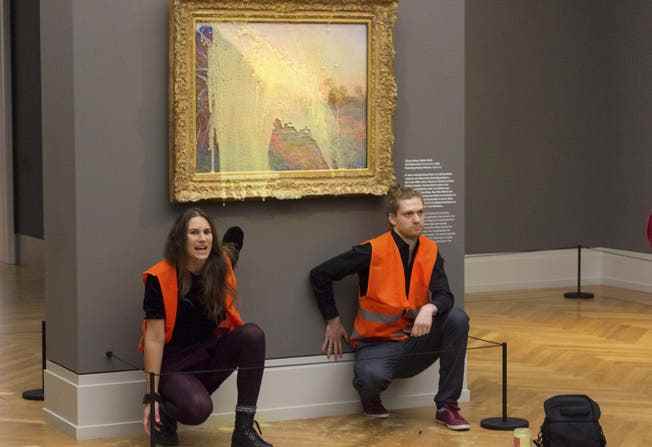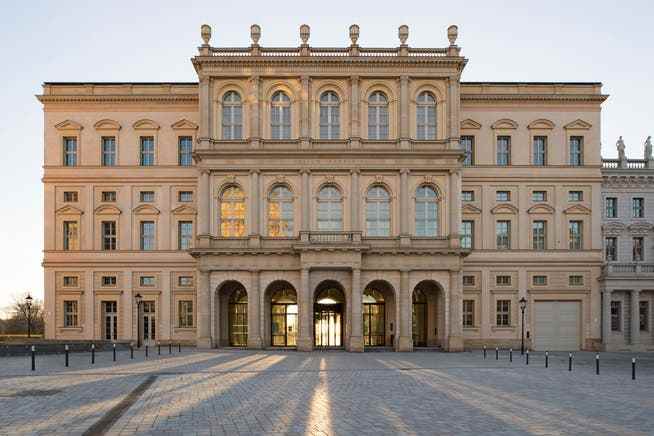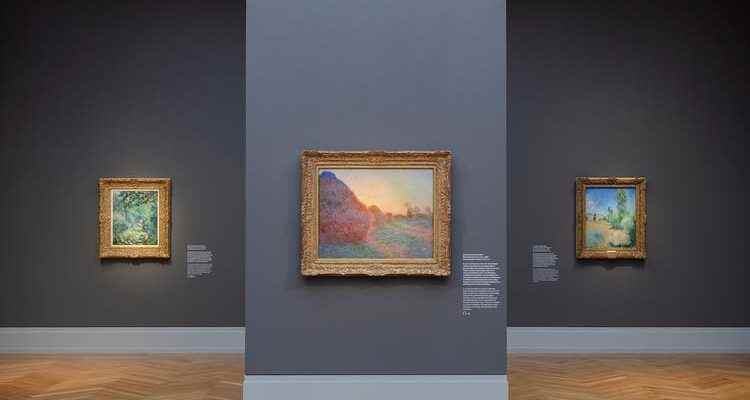Environmental activists staged their attacks on valuable art in a media-effective manner. Museums are forced to adapt their security concepts. Are cultural sites becoming a high-security zone?
After the restoration, Claude Monet’s “Grainstack” can be seen again in the Museum Barberini.
Monet’s «Grainstack» is hanging in its original place again. On the anthracite gray wall with a white base, bordered by a calf-high barrier and surrounded by other Monets from the series “Les Meules” (“The Haystacks”). There is no longer any indication that radical leftists smeared the painting with mashed potatoes.
A week ago on Sunday, radical climate activists from the “Last Generation” group at the Barberini Museum in Potsdam threw mashed potatoes at Claude Monet’s painting, then glued themselves to it. They were taken into police custody but were released the same day. The damage caused is said to be in the five-digit range, the painting had to be restored and the room repainted.
The founder of the museum, Hasso Plattner, is said to have bought the Monet painting in question for more than $100 million. The German entrepreneur and patron of the arts supports several of the city’s projects with financing worth millions.
Attacks on valuable works of art are increasing in European countries. In London, activists poured tomato soup on Van Gogh’s “Sunflowers” painting. Last weekend, two members of the “Last Generation” stuck in the Berlin Natural History Museum.
Only the felt strip between the glass and the painting prevented serious damage, says museum director Ortrud Westheider this Monday in the museum’s café. Without the felt strip, the mush liquid might have damaged the canvas. What feelings does the attacks on paintings trigger in her? “It’s a great horror for us,” says the art historian. She is shocked by the aggressiveness of the climate activists: “This is violence.” According to the director, the museum is also an ecosystem that needs to be protected.

After their mashed potatoes toss, the radical members of the Last Generation group glued themselves under the Monet painting.
“I think Mr. Monet would have liked that”
Not everyone condemned the attack so harshly. The museum opens at 10 a.m., shortly before that a long queue has formed in front of the entrance. A middle-aged woman rates the action positively, something has to happen, she says as she stands in line. A couple in their 50s has a split opinion. “I think Mr. Monet would have liked that,” says the wife, who works as a lawyer. Her husband disagrees. The action was “idiotic”.
The scenery while waiting for admission is worth painting on this day. The Barberini Museum is located in the historic center of Potsdam, not far from where Chancellor Scholz lives. Opposite the museum is the Nikolaikirche, the Brandenburg state parliament is to the west in the pink-painted city palace. The visitors came from all over Germany, in some federal states today is free because of the Reformation Day.
The rush is great, a man on a bicycle waves his hand when he sees the queue. Inside, people are sometimes as dense as they were in the pre-Corona days. They all have to hand in their bags and jackets as part of the new security routine, the museum’s response to the Monet attack. The security staff has also been visibly increased.
TV cameras and visitors alternate in front of Claude Monet’s restored “Grainstack” on the second floor of the building. The security staff eye the visitors closely and turn around if something seems strange.
A ballpoint pen drawn out immediately draws the attention of an employee in a Securitas jacket. Instead, she kindly hands out a pencil: “You have to watch out for everything.” Again and again a high pitched beep sounds in the exhibition rooms when someone gets too close to the pictures behind the barrier. The warning signal is usually triggered because people point their fingers at the pictures.
Civil suit for the Mashed Potato Throwers
The art world is concerned. Just a minute’s walk from the Barberini is the Potsdam City Museum, where the staff is also concerned. The security standards are already high, but talks are being held with the security service providers to tighten the precautions.
In the lower rooms there are works of surrealism, Enrico Donati’s sculpture “The Evil Eye”, oil canvases with melted figures reminiscent of paintings by Salvador Dalí. Many visitors are near retirement age, but students, tourists and children are also in the museum, some listening to an audio guide on their mobile phones.

The Museum Barberini opened in 2016 in the heart of Potsdam.
Most visitors who are asked about the mashed potatoes attack are also concerned about climate change, but find the action inappropriate. “The political message is contradictory,” says a gentleman in his sixties in a corn-blue jacket with a handkerchief. “You can’t want to save the world while destroying cultural assets at the same time.” He and his wife come regularly from Berlin, they like the presentation of the museum.
Do young people have more sympathy for their peers who put themselves on streets, pictures and cars to draw attention to climate change? Rather not. A 20-year-old medical student shakes her head: “No, you don’t do that,” she says. Two students in their twenties from Mannheim are also critical of the mashed potatoes campaign: “It’s the wrong way,” says the computer science student.
What consequences do the mashed potatoes throwers expect? The lawyers of the “Hasso Plattner Foundation” are currently examining this. They are in the process of preparing a civil lawsuit, says museum director Westheider. The attack occupies the art historian, who has headed the Barberini since 2016: “There are nicer things than a director.”
